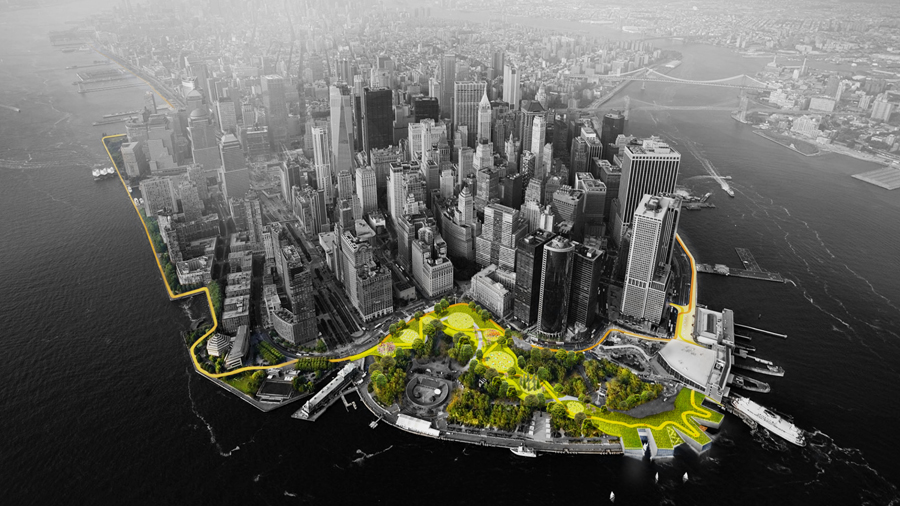Crowdsourcing Coastal Resilience
 A Rebuild By Design competition winner includes a park along the lower tip of Manhattan with raised berms for flood protection that also serves as a park. Image courtesy Bjarke Ingels Group
A Rebuild By Design competition winner includes a park along the lower tip of Manhattan with raised berms for flood protection that also serves as a park. Image courtesy Bjarke Ingels Group
Hurricane Sandy, whose 8-foot storm surges destroyed whole communities in New York and New Jersey in 2012, not only exposed widespread vulnerability to climate-related flooding. It also served as a wake-up call to engineers and governments about the need to re-imagine life along the coast. Simply replacing damaged sea walls made little sense, given the extent of the devastation – including 1117 dead and $71 billion in damage, including Manhattan’s venerable subway system.
Dutch designer Henk Ovink, an expert in flood-resilient buildings who was serving as an adviser to President Obama’s Hurricane Sandy Rebuilding Task Force, hit on a way to generate those innovative solutions: crowdsource the problem.
“It’s a paradigm shift from seeing water as a threat and just wanting to be protected to saying water is part of our life. Living with the water is a better perspective to moving forward,” he told the PBS Newshour.
In June 2013, the task force and U.S. Department of Housing and Urban Development launched the Rebuild by Design competition. From an initial 148 submissions from around the world, six projects – ranging from living reefs to a series of raised berms across lower Manhattan – were chosen to receive awards from $20 million to $335 million.
Today, Rebuild By Design has grown to include 100 “resilient cities” collaborating on research and design, policy and research efforts, and a Resilience By Design University initiative that includes New York University, the University of Pennsylvania School of Design, and Columbia University’s Graduate School of Architecture, Planning, and Preservation working to build an open-sourced interdisciplinary curriculum for a fundamentals course about design and resilience planning. The academics and design professionals were involved in the Hurricane Sandy Design Competition.
Click HERE (Columbia University) and HERE (PBS) for list of winners, write-ups, and links to videos.
Top prize: The Big U $335 million.
BIG U: A Day in the Life from Rebuild by Design on Vimeo.
The Bjarke Ingels Group (BIG) proposed creating a vertical protection system of raised berms and bridges planted with salt-tolerant plants covering ten miles of coast across lower Manhattan. There are flood walls that can be raised in a disaster, but there are recreation spaces as well. A new Maritime Building would include a “Reverse Aquarium” on the water-facing ground floor to educate visitors about the marine life.
Resist, Delay, Store, Discharge – $230 million
Resist, Delay, Store, Discharge: A Comprehensive Strategy for Hoboken from Rebuild by Design on Vimeo.
OMA’s plan for Weehawken, Hoboken, and Jersey City looks at flood prevention and drainage for the towns. Two-thirds of Hoboken lies in a FEMA flood zone, and 94 percent of its surfaces are impermeable, trapping water. Building wetlands along the towns will delay incoming ocean-water, and filter outgoing storm water. Permeable paving, rain gardens, and bioswales allow surface water to drain, and a rainwater storage system will filter rainwater while serving as a public park.
Living Breakwaters – $60 million
UPDATE: Living Breakwaters from Rebuild by Design on Vimeo.
The Living Breakwaters project builds out Staten Island’s shoreline, building a marshland system along the shore supported on underwater berms. The berms, made of eco-friendly concrete, serve as a place for wildlife like clams and mussels to build their homes. Plans included a wetland education center for islanders, areas for kayak and recreational equipment storage, and support for the local fishing community.
Building wetlands lets the water out in the event of a flood, filtering it and cleaning the surrounding bay. By contrast, a wall would hold water on the island like a bathtub and further disconnect New Yorkers from their marine surroundings.
Filed under: Special Features
Tags: Civil Engineering, coastal engineering, crowdsourcing, design contest, Environmental Engineering, flooding, Hurricane Sandy, New York, Public Policy, rebuild by design, resilient structures








